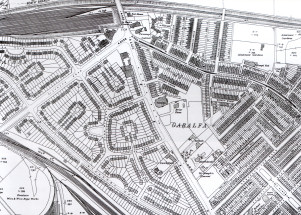THE HISTORY OF CARDIFF'S SUBURBS
GABALFA
Incorporating Mynachdy
CONTENTS
Tap or click to open / closeA Small Hamlet
For centuries Gabalfa was a sparsely populated hamlet in the parish of Llandaff. The name, meaning place of the ferry, is a reminder of how people crossed the river before a bridge was built at Western Avenue.
An 1879 survey shows a few houses along North Road, among them Northlands, Heathlands and Maendy lodge.
Source: OS
The 18th-century farmhouse of Llys Talybont, lay close to Mynachdy Farm between North Road and the Taff Vale Railway.
The manor of Llys Talybont, was once owned by Llantarnam Abbey in Caerleon, which may explain how Mynachdy, the Welsh word for 'Monks House', gained its name.
The manor became a part of the Cardiff Castle Estate when the Earl of Pembroke acquired it following the Dissolution of the Monasteries. The farmhouse still exists and is now used by the council as a training and development centre.
St Mark the Evangelist Church
The original church of St Mark the Evangelist was consecrated (literally meaning "to associate with the sacred") in 1876 and stood at the junction of North Road and Whitchurch Road.
The church ensured that Gabalfa became a parish in it's own right. The building was demolished to make way for the flyover, and a replacement Church was built on North Road in 1967.
Western Avenue (A48)
The construction of Western Avenue from Ely Bridge to North Road followed a decision to build an inner bypass for Cardiff. It was finished in 1933 at a cost of £150,000, but the Ministry of Transport initially refused to finance a continuation of the route eastwards.
The busy flow of traffic along North Road, Whitchurch Road and Western Avenue made its completion essential but 40 years were to pass before the Queen officially opened Eastern Avenue in December 1971. After World War Two, the Glamorganshire Canal was filled in and a large council estate was built alongside Western Avenue.
Gabalfa Interchange
The building of the Gabalfa Interchange had far reaching effects on the northern boundary of the suburb. Excavations were necessary to form the new highway linking Western and Eastern avenues.
Two bridges were built above the avenue, as part of a roundabout controlling the traffic flow along five roads, while a flyover provided a third tier carrying vehicles directly towards the city centre.
More than 100 houses as well as a number of other landmarks disappeared, among them the local library and the Regal Dance Hall. The most notable casualties of progress were St Marks Church and its vicarage.
A final service was held in April 1968, after which worshippers moved to their new church a short distance away in North Road.
Llys Talybont
The modern electoral district of Gabalfa scarcely compares with the original parish which included districts now in Llandaff North, Cathays, Llanishen and Whitchurch.
During the latter half of the 20th century, the population of Gabalfa like many inner-city suburbs, was in decline. But that trend was halted when Halls of Residence at Llys Talybont, almost a village in its own right, was built to accommodate some of Cardiff's large student population.
PAGE UPDATE HISTORY
01 April 2024 (Content and coding updates)
01 December 2014 (Page updated)
July 2009 (Page Created)

